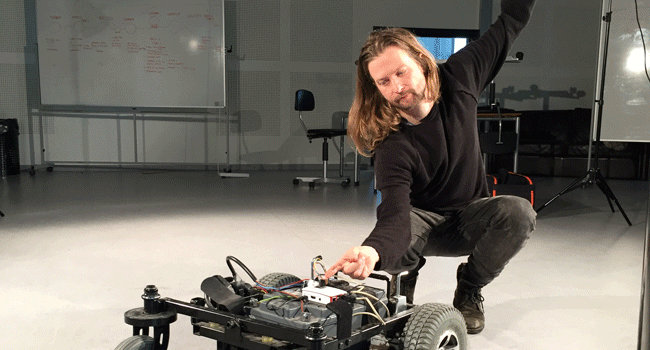The Dynamic Still
Jeroen Derks, Hartvig Hansen, Elizabeth Jochum, Thomas Kristensen, Alberte Husted Larsen, Barnabas Varszegi, Miguel Castro, Sandro Masai
Can robots improvise? Performance artists increasingly use computers and other smart devices to generate art works, but at what point does technology stop being a tool and become a performer? This improvisational performance investigates creative performance between living and non-living actors— a human being and an intelligent mobile robot. None of the performance is pre-scripted or tele-operated; audiences watch the actors communicate and improvise to develop an original performance. The project is developed by RELATE - Research Laboratory for Art and Technology at AAU.
Improvisational acting for robots
Performance artists increasingly use computers and other smart devices to generate art works, but at what point does technology stop being a tool and become a performer? This research project explores improvisational performance between living and non-living actors— a human being and an intelligent mobile robot. None of the performance is pre-scripted or tele-operated; audiences watch the actors communicate and improvise to develop an original performance.
Improvisation is an established training and performance practice in theatre and dance. It is also a powerful tool for generating unscripted and creative scenarios and devised performances. In theatre, actors use improvisational acting exercises to generate real-time, interactive storylines and performances with unpredictable outcomes. In dance, the practice of contact improvisation uses points of physical contact between dance partners as a catalyst for exploring movement improvisations. These improvisations can be used to devise scripted performances that will be repeated, or they can be used as performance techniques to generate novel, non-repeatable performances. Improvisation is considered fundamental for human performers, and is a hallmark of creativity and responsiveness.
When robots appear in theatre performances, they typically inhabit the role of a scripted character and are either tele-operated or pre-programmed according to the dictates of a script. The script provides the blueprint for performance, where the robot behaviors and choreography are designed and programmed in accordance with the dramaturgy. Taking our cue from improvisational theatre, we do not start with a script but rather with physical improvisations to develop a live performance. Our research methodology uses a bottom-up approach to find computational abstractions for basic movement improvisation exercises taken from acting and dance. Using these building blocks grounded in physical motion and choreography, we create a set of improvisational exercises that facilitate open-ended, unscripted interactions between a human and a robot. We developed a customized tracking system using HTC Vive controllers that track the orientation and three dimensional movements of the robot and human in real time. We use an open-experimentation rehearsal model, and the performance will be featured at the International Improv Festival in Denmark (March 2017). The project is developed by RELATE - Research Laboratory for Art and Technology at Aalborg University in Denmark.



